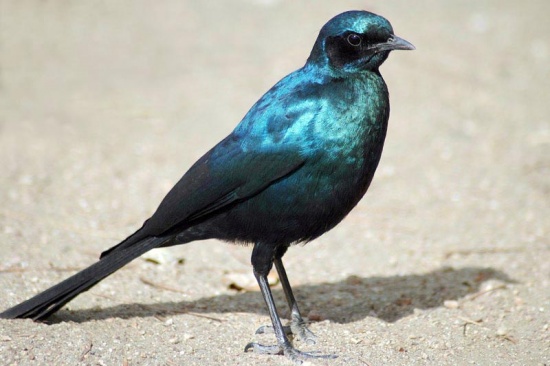m |
(→External Links: Added variant English names.) |
||
| (9 intermediate revisions by 5 users not shown) | |||
| Line 1: | Line 1: | ||
| + | [[Image:Burchells_Glossy_Starling.jpg|thumb|550px|right|Photo by {{user|Peter+van+Zoest|Peter van Zoest}}<br />[[South Africa]], July 2005]] | ||
| + | '''Alternative name: Burchell's Glossy Starling; Greater Glossy Starling''' | ||
;[[:Category:Lamprotornis|Lamprotornis]] australis | ;[[:Category:Lamprotornis|Lamprotornis]] australis | ||
| − | |||
==Identification== | ==Identification== | ||
Length 30 cm, mass 112-128 g. | Length 30 cm, mass 112-128 g. | ||
| + | * Glossy blue-green plumage | ||
| + | * Bronze ear-coverts and carpal patch | ||
| + | * Purple rump | ||
| + | * Violet tail with blackish bars | ||
| + | * Dark brown eye | ||
| + | * Black bill and legs | ||
| + | Sexes similar. Juveniles have matt black underparts and dull green sheen on upperparts. | ||
| + | ====Similar species==== | ||
| + | The contrasting dark mask and the often partly exposed dark centres of upperwing-coverts and scapulars help separating this species from [[Meves's Glossy-Starling]]. | ||
| + | ==Distribution== | ||
| + | [[Botswana]], central and northern [[Namibia]], southern [[Angola]], western [[Zambia]], northern [[South Africa]] and eastern [[eSwatini]].<br /> | ||
| + | Locally common. | ||
| − | + | ==Taxonomy== | |
| + | This is a [[Dictionary_M-O#M|monotypic]] species<sup>[[#References|[1]]]</sup>. | ||
| − | |||
| − | |||
| − | |||
| − | |||
| − | |||
==Habitat== | ==Habitat== | ||
Open woodland and savanna. | Open woodland and savanna. | ||
==Behaviour== | ==Behaviour== | ||
| − | A common resident that occurs singly, in small groups, or in flocks, sometimes with other glossy starlings. Feeds largely on the ground, mainly for insects; also eats small vertebrates, fruit and flowers. Often a scavenger at picnic sites in game reserves. | + | A common resident that occurs singly, in small groups, or in flocks, sometimes with other glossy starlings. Feeds largely on the ground, mainly for insects; also eats small vertebrates, fruit and flowers.<br /> |
| + | Often a scavenger at picnic sites in game reserves. | ||
| + | ====Breeding==== | ||
| + | A [[Dictionary_M-O#M|monogamous]] species. Usually nests in a hole in a tree; often an old woodpecker or barbet nest. Two to four eggs are laid October to April.<br /> | ||
| + | Parasitised by [[Great Spotted Cuckoo]] and [[Greater Honeyguide]]. | ||
| − | + | ====Vocalisation==== | |
| + | The song comprises short phrases of rolling whistles and harsh notes. | ||
==References== | ==References== | ||
| − | + | #{{Ref-Clements6thDec10}}#{{Ref-Hockeyetal05}}#{{Ref-HBWVol14}} | |
| + | {{ref}} | ||
==External Links== | ==External Links== | ||
| − | {{GSearch|Lamprotornis | + | {{GSearch|"Lamprotornis australis" {{!}} "Burchell's Starling" {{!}} "Burchell's Glossy-Starling" {{!}} "Greater Glossy Starling" }} |
| + | {{GS-checked}}1 <br /><br /> | ||
[[Category:Birds]] [[Category:Lamprotornis]] | [[Category:Birds]] [[Category:Lamprotornis]] | ||
Latest revision as of 23:19, 21 October 2023
Alternative name: Burchell's Glossy Starling; Greater Glossy Starling
- Lamprotornis australis
Identification
Length 30 cm, mass 112-128 g.
- Glossy blue-green plumage
- Bronze ear-coverts and carpal patch
- Purple rump
- Violet tail with blackish bars
- Dark brown eye
- Black bill and legs
Sexes similar. Juveniles have matt black underparts and dull green sheen on upperparts.
Similar species
The contrasting dark mask and the often partly exposed dark centres of upperwing-coverts and scapulars help separating this species from Meves's Glossy-Starling.
Distribution
Botswana, central and northern Namibia, southern Angola, western Zambia, northern South Africa and eastern eSwatini.
Locally common.
Taxonomy
This is a monotypic species[1].
Habitat
Open woodland and savanna.
Behaviour
A common resident that occurs singly, in small groups, or in flocks, sometimes with other glossy starlings. Feeds largely on the ground, mainly for insects; also eats small vertebrates, fruit and flowers.
Often a scavenger at picnic sites in game reserves.
Breeding
A monogamous species. Usually nests in a hole in a tree; often an old woodpecker or barbet nest. Two to four eggs are laid October to April.
Parasitised by Great Spotted Cuckoo and Greater Honeyguide.
Vocalisation
The song comprises short phrases of rolling whistles and harsh notes.
References
- Clements, JF. 2010. The Clements Checklist of Birds of the World. 6th ed., with updates to December 2010. Ithaca: Cornell Univ. Press. ISBN 978-0801445019. Spreadsheet available at http://www.birds.cornell.edu/clementschecklist/Clements%206.5.xls/view
- Hockey, PAR, WRJ Dean, and PG Ryan, eds. 2005. Roberts' Birds of Southern Africa. 7th ed. Cape Town: John Voelcker Bird Book Fund. ISBN 978-0620340533
- Del Hoyo, J, A Elliott, and D Christie, eds. 2009. Handbook of the Birds of the World. Volume 14: Bush-shrikes to Old World Sparrows. Barcelona: Lynx Edicions. ISBN 978-8496553507
Recommended Citation
- BirdForum Opus contributors. (2024) Burchell's Starling. In: BirdForum, the forum for wild birds and birding. Retrieved 12 May 2024 from https://www.birdforum.net/opus/Burchell%27s_Starling
External Links
GSearch checked for 2020 platform.1




